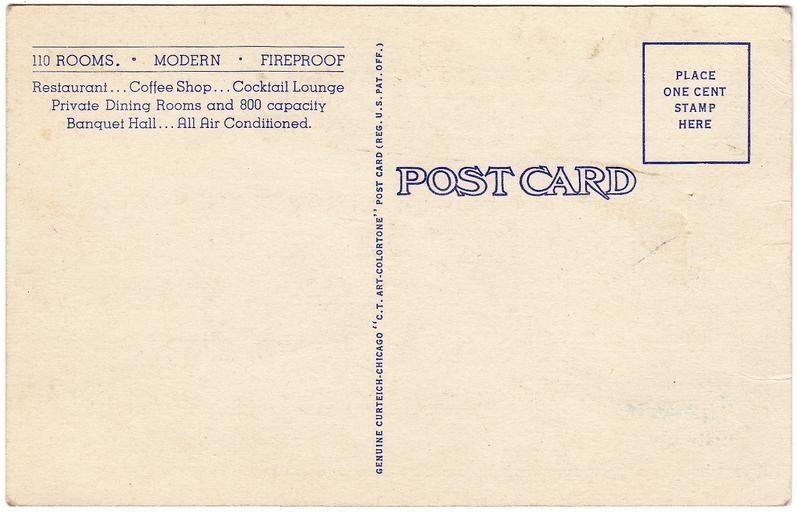MAKE A MEME
View Large Image

| View Original: | Back_of_Hotel_Manchester,_Middletown,_Ohio_(Date_Unknown).jpg (1246x800) | |||
| Download: | Original | Medium | Small | Thumb |
| Courtesy of: | www.flickr.com | More Like This | ||
| Keywords: postcard postcards unused divided back dividedback hotels hotel manchester hotelmanchester middletown, ohio middletownohio middletown ohio linen curt teich co. curtteichco curteich curteich-chicago curteichchicago c.t. art colortone ctartcolortone date unknown dateunknown unknown date unknowndate text document Description on front of card: Hotel Manchester John B. Minnich, Mgr. Middletown, Ohio Restaurant Private dining rooms Cocktail lounge Coffee shop All air conditioned Description on back of card: 110 Rooms - Modern - Fireproof Restaurant...Coffee Shop...Cocktail Lounge Private Dining Rooms and 800 capacity Banquet Hall...All Air Conditioned. Published by: Curteich-Chicago "C.T. Art-Colortone" by Curt Teich Co., Chicago, Illinois Unused. Publisher Note: Curt Teich emigrated to Chicago in 1895. He had worked as a lithographer in Lobenstein, Germany. He founded the Curt Teich Company in 1898, concentrating on newspaper and magazine printing. He was an early publisher of postcards, but he didn't begin printing them himself until 1908. According to MetroPostcard.com, "As his competition dwindled, his sales expanded and his American factories would eventually turn out more postcards than any other in the United States." The company was best known for their wide range of advertising and postcards of North America. By the 1920s, it was producing so many postcards with borders that they became recognized as a type dubbed "White Border Cards," creating an "era." Curt Teich started using offset presses in 1907, but it took a number of years before he had offset presses made to his satisfaction, and many more years for him to perfect the method. His innovations in this printing technique directly led to the production of what we now call "linens" by the early 1930s. The company aided the war effort during the second world war by also printing many military maps. Curt Teich eventually turned management of the company over to his son, but he remained active in company operations throughout its history. Curt Teich died in 1974 and the family business was sold to Regensteiner Publishers who continued to print postcards at the Chicago plant until 1978 when the rights to the company name and processes were sold to the Irish company, John Hinde Ltd. Their California subsidiary now prints postcards under the name John Hinde Curteich, Inc. Source: www.metropostcard.com/publisherst.html Description on front of card: Hotel Manchester John B. Minnich, Mgr. Middletown, Ohio Restaurant Private dining rooms Cocktail lounge Coffee shop All air conditioned Description on back of card: 110 Rooms - Modern - Fireproof Restaurant...Coffee Shop...Cocktail Lounge Private Dining Rooms and 800 capacity Banquet Hall...All Air Conditioned. Published by: Curteich-Chicago "C.T. Art-Colortone" by Curt Teich Co., Chicago, Illinois Unused. Publisher Note: Curt Teich emigrated to Chicago in 1895. He had worked as a lithographer in Lobenstein, Germany. He founded the Curt Teich Company in 1898, concentrating on newspaper and magazine printing. He was an early publisher of postcards, but he didn't begin printing them himself until 1908. According to MetroPostcard.com, "As his competition dwindled, his sales expanded and his American factories would eventually turn out more postcards than any other in the United States." The company was best known for their wide range of advertising and postcards of North America. By the 1920s, it was producing so many postcards with borders that they became recognized as a type dubbed "White Border Cards," creating an "era." Curt Teich started using offset presses in 1907, but it took a number of years before he had offset presses made to his satisfaction, and many more years for him to perfect the method. His innovations in this printing technique directly led to the production of what we now call "linens" by the early 1930s. The company aided the war effort during the second world war by also printing many military maps. Curt Teich eventually turned management of the company over to his son, but he remained active in company operations throughout its history. Curt Teich died in 1974 and the family business was sold to Regensteiner Publishers who continued to print postcards at the Chicago plant until 1978 when the rights to the company name and processes were sold to the Irish company, John Hinde Ltd. Their California subsidiary now prints postcards under the name John Hinde Curteich, Inc. Source: www.metropostcard.com/publisherst.html | ||||